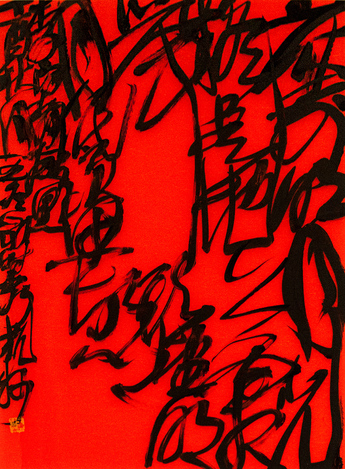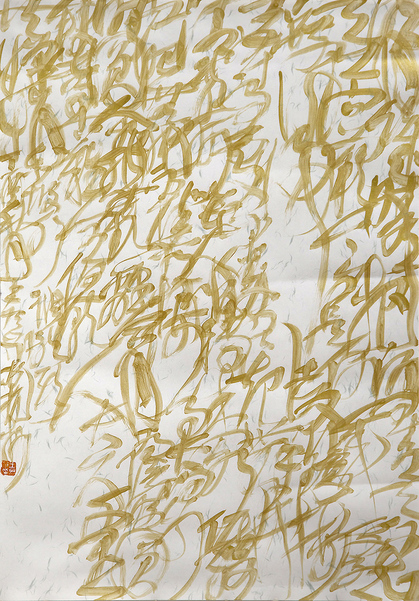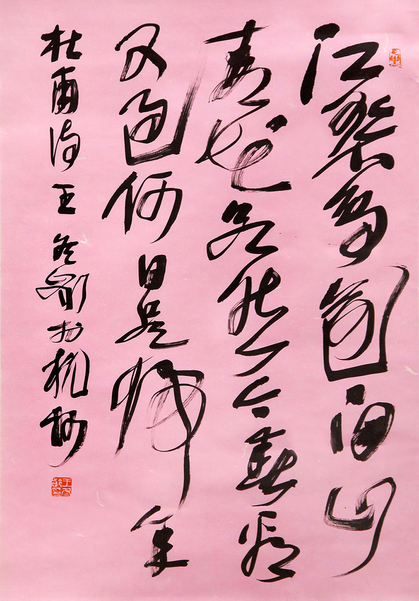-
From Current Issue
-
- Editor’s Letter Fire in the Heart
- Reviews I Gusti Ayu Kadek Murniasih
- Reviews 11th Seoul Mediacity Biennale: “One Escape at a Time”
- Dispatch Networked China
- One on One Monira Al Qadiri on Yukio Mishima
- Essays The rise of independent art spaces in pandemic-era Shanghai
- Features Tuan Andrew Nguyen
- Table of Contents
- Web Exclusives
- Archive
- Subscribe

R
E
V N
E
X
T
Wang Dongling returned to Hong Kong with a new series of works for “Poetic Rainbow,” an exhibition staged at Hanart TZ Gallery. Hanart founder Johnson Chang felt that there is a lack of representation for Chinese calligraphy in the city’s contemporary art scene; with that in mind, Chang and Wang reintroduced Chinese calligraphy to the port city with a new twist. In this set of work, words from Tang and Song poems are reinterpreted alongside pop song lyrics. The artist’s new creations are a remarkable departure from the black-and-white ink works that he has shown before; this time, color plays a key role.
As a master of modern Chinese calligraphy, Wang pioneered something that he calls “Entangled Script,” examples of which were seen in colored see-through panels, such as Su Shi ‘Nian Nu Jiao: Memories of the Past at Red Cliff’, Entangled Script (all works 2017), hung diagonally across the gallery’s main space. When viewed in the right line of sight, the acrylic boards overlap. Wang’s anarchic brushstrokes look stunning and harmonious, with different shades of color melding together for a fresh display of a traditional art form.
Wang’s wild—but controlled—strokes are agitated further when the artist’s works are placed near a light source; these calligraphic creations cast shadows onto the surfaces around them, further blurring the text. The artist is most content with this effect being achieved in Li Bai, ‘Night Thoughts’, Entangled Script. In the gallery, the piece, which was executed on a red see-through board, was flanked by the blue-backed Wang Wei, ‘The Bamboo Grove Pavilion’ and the yellow field of Wang Wei, ‘Yearning.’ The presentation reflected a fusion between Chinese calligraphy and Western color theory, demonstrating the artist’s interest in both arenas.
Su Shi, ‘Prelude to the Water Melody’ shows black-and-white entangled script executed in a manner that leans toward classical arrangements, though Wang’s entangled script breaks tradition, liberating the 11th-century poet’s verses from the “implied grid” and clear structure of classical Chinese calligraphy. The artist’s unique style gives these words a vivid, new form, and heightens the poem’s literary expressiveness, even reminding one of the variation in rhythm and tone in a piece of music.
An intimate showcase of Wang’s smaller calligraphy pieces on colored paper was in Hanart TZ’s side gallery. Some of the works were executed in gouache on paper, such as Xin Qiji ‘Green Jade Table: First Full Moon of the Year’ with white text offsetting a maroon background. Several of the artist’s cursive script works were shown, including Du Fu ‘Quatrains’, Grass Script, reasserting the master’s technical roots, with the use of colored paper echoing descriptions of nature and life in poetry that is centuries old as well as contemporary pop songs. Wang’s playful takes on modern Chinese pop lyrics—including those from James Wong’s 1980 hit “The Bund of Shanghai”—are a contrast to his other works. The artist explained his choices based on how these tunes entice responses from listeners.
During the opening reception at Hanart TZ Gallery, Wang executed a live performance, creating a new work with white paint on a glass screen to mark the occasion. He entered his inner world, using the brush as an extension of himself to express his feelings and spirit. The artist has said that he chooses calligraphy as his key medium because he favors the softness of the Chinese ink brush’s bristles, which enables versatility, immediacy and expressiveness. In Wang’s hands, such a brush is the perfect tool to breathe new life into a field where the styles and technique have deep roots.
Helena Halim is ArtAsiaPacific’s editorial intern.
Wang Dongling’s “Poetic Rainbow: The Calligraphy of Wang Dongling” is on view at Hanart TZ Gallery, Hong Kong, until October 27, 2017.
To read more of ArtAsiaPacific’s articles, visit our Digital Library.







